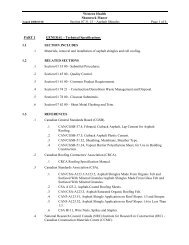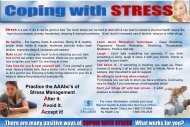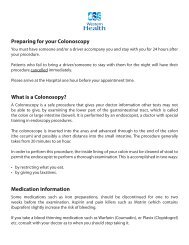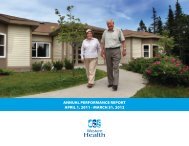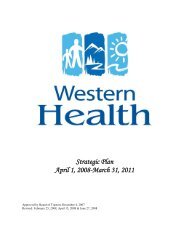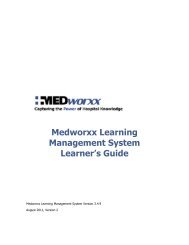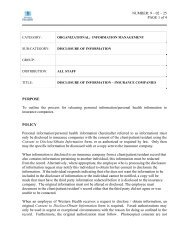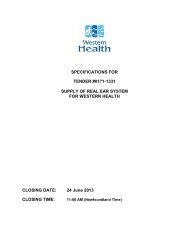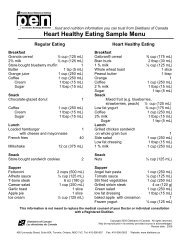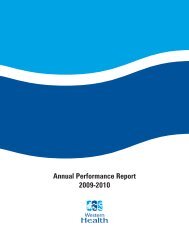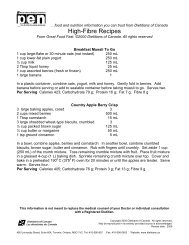A Risk Assessment Screening Tool for Community ... - Western Health
A Risk Assessment Screening Tool for Community ... - Western Health
A Risk Assessment Screening Tool for Community ... - Western Health
You also want an ePaper? Increase the reach of your titles
YUMPU automatically turns print PDFs into web optimized ePapers that Google loves.
Home <strong>Health</strong> Care Management Practice OnlineFirst, published on November 6, 2009 as doi:10.1177/1084822309348893A <strong>Risk</strong> <strong>Assessment</strong> <strong>Screening</strong> <strong>Tool</strong> <strong>for</strong><strong>Community</strong> <strong>Health</strong> Care WorkersHome <strong>Health</strong> Care Management & PracticeXX(X) 1 –5© 2009 SAGE PublicationsReprints and permission: http://www.sagepub.com/journalsPermissions.navDOI: 10.1177/1084822309348893http://hhcmp.sagepub.comElaine Lundrigan, MAd Ed, 1 Darlene Hutchings, MHSTc, 2Maria Mathews, PhD, 3 Anne Lynch, MHSC, 2 and Joanne Goosney, BSW 2AbstractGiven the shift to community-based care, health care providers are facing an increased risk of workplace violence. Theprocess of minimizing risk <strong>for</strong> staff providing home visits is a challenge and has not been extensively studied. The authorsdescribe the development and implementation of a risk assessment instrument in a regional health authority in Newfoundland.The instrument aids community workers to identify and manage potential workplace violence risks. The process and riskassessment instrument may be useful to other health care organizations interested in promoting workplace safety.Keywordsrisk assessment screening tool, workplace violence, community health care providers, safety programsIntroductionThere is general consensus throughout the literature thatimportant factors to enhance safety <strong>for</strong> workers in any healthcare setting include the health care organization’s commitmentto safety and employees’ awareness of safety issues.Various definitions of workplace violence exist. The CanadianCentre <strong>for</strong> Occupational <strong>Health</strong> and Safety (CCOHS; 2007)defines workplace violence as “any act in which a person isabused, threatened, intimidated, or assaulted in his or heremployment” (p. 1). Included in this definition is a range ofviolent physical and psychological acts such as threateningbehaviors, verbal or written threats, and/or physical attacks(Di Martino, 2002; Leck, 2002).Although violence in the workplace affects all professions,health care and social service employees are at ahigher risk (Canadian Nurses Association [CNA], 2002;Di Martino, 2002; Kinross, 1992; Munson, 2002; OccupationalSafety and <strong>Health</strong> Administration, 2003; Rippon,2000; Whitehorn & Nowland, 1997). In fact, the CNA reportsthat health care workers are 16 times more likely to experienceworkplace violence than any other profession, and DiMartino (2002) reports that almost one quarter of all violentincidents in the workplace is experienced by the healthsector. Although violence or threats are sometimes minor innature, this violence can produce long-term psychologicalconsequences (Brillhart, Kruse, & Heard, 2004; Rippon,2000) and can have a negative impact on sick leave, absenteeism,retention, productivity, and motivation (Di Martino,2002; Leck, 2002; Lundstrom, Pugliese, Bartley, Cox, &Guither, 2002).Although it is somewhat difficult to reliably identify predictorsof violence, there is widespread agreement about thetype of clients or their families and or situations that maypose the greatest risk to health care workers. For example,high-risk clients include individuals with a history of assaultor criminality, possession of weapons, alcohol or substanceabuse; people exhibiting psychosis with dementia; poorsocial supports; or <strong>for</strong> whom past contact with health careorganizations has resulted in mistrust of the system (CCOHS,2007; Elliott, 1997; Galloway, 2002; Henry & Henry, 1997;Occupational Safety and <strong>Health</strong> Administration, 2003;Public <strong>Health</strong> Agency of Canada, 2002; Workers CompensationBoard of British Columbia, 2005). Instances whereheath care providers work alone also pose risks.<strong>Western</strong> <strong>Health</strong>, like other organizations that providecommunity-based health care services, recognized the needto promote employee safety by reducing the risk of workplaceviolence. <strong>Western</strong> <strong>Health</strong> is a regional healthauthority serving a population of 79,460 on the west coastof Newfoundland (Statistics Canada, 2006). It provides bothinstitutional and community-based health and social services(including communicable disease control, health promotion,1 <strong>Western</strong> Regional School of Nursing, Corner Brook, Newfoundland,Canada2 <strong>Western</strong> <strong>Health</strong>, Corner Brook, Newfoundland, Canada3 Memorial University of Newfoundland, St. John’s, Newfoundland, CanadaCorresponding Author:Elaine Lundrigan, <strong>Western</strong> Regional School of Nursing, P.O. Box 2005,Corner Brook, Newfoundland, Canada A2H 6J7Email: elundrig@swgc.mun.ca
Lundrigan et al. 3Table 1. <strong>Western</strong> <strong>Health</strong> <strong>Risk</strong> <strong>Assessment</strong> <strong>Screening</strong> <strong>Tool</strong>Reason <strong>for</strong> visit: ______________________________________• If apprehending a child, consult with a managerto discuss the need <strong>for</strong> a police escort.High <strong>Risk</strong> Yes No Don’tKnow1. Is there a potential <strong>for</strong> violence or aggressionin the home (i.e., domestic violence, sexual abuse,violence/aggression with service providers, etc.)?2. Is there a history of weapon-related incidents?• If Yes, consult with a manager to develop a safetyplan (i.e., buddy system, police escort, etc.).• If Don’t Know, carry a cell phone, consult withstaff who know the family, or consult with amanager.• Reminder: complete the Sign-In/Sign-Out Sheetbe<strong>for</strong>e conducting the visit.Moderate <strong>Risk</strong> Yes No Don’tKnow3. Has the client or client’s family been verballyabusive to service providers?4. Are there any illnesses/conditions that might affectclient’s behavior (e.g., dementia, psychosis, braintrauma, etc.)?5. Is there a history of drug or alcohol abuse in thehome?6. Have there been false allegations from this clientabout service providers?7. Is the cell phone service inadequate?8. Is the home located in an area that one mightconsider dangerous?• If Yes to more than one of the questions in thiscategory, consult with a manager to discusssafety precautions.• If there are false allegations from this clientabout service providers, consult with a managerto discuss safety precautions.• If there are dangerous animals on the property,request an office visit with the client (ifpossible) or request that the client restrainthe animal. If the client refuses to restrain theanimal, leave the home.• If Don’t Know, carry a cell phone, consult withstaff who know the family, or consult with amanager.• Reminder: complete the Sign-in/Sign-Out Sheetbe<strong>for</strong>e conducting the visit.9. Are there dangerous animals on the property?Low <strong>Risk</strong> Yes No Don’tKnow10. Is the home in an area that is physically isolatedfrom other homes?11. Are there any factors affecting access to thehome (e.g., lighting, broken stairs, parking, etc.)?• If Yes, take the necessary safety precautionsbe<strong>for</strong>e conducting the visit.• Reminder: complete the Sign-In/Sign-Out Sheetbe<strong>for</strong>e conducting the visit.Source: Lundrigan, E., Hutchings, D., Lynch, A., Goosney, J., & Mathews, M. (2008). Table developed by authors.revisions to the tool following the evaluation. Following thepilot, the WHRAST was implemented regionally.The <strong>Western</strong> <strong>Health</strong> <strong>Risk</strong><strong>Assessment</strong> <strong>Screening</strong> <strong>Tool</strong>The WHRAST (Table 1) is designed to be completed byindividual health professionals prior to carrying out eachcommunity-based visit. For each item, individuals areasked to answer a series of questions related to risk factorsthat have been grouped into high, moderate, and lowrisk. Depending on the response to each risk factor and thenumber of “yes,” “no,” or “don’t know” responses to specificitems, appropriate safety protocols are identified. Itshould be noted that the WHRAST is intended to be used aspart of a larger safety program that includes protocols suchas a sign-in/sign-out system, buddy system, as well as ongoingeducation about staff safety.The sign-in/sign-out system was a means of trackingemployees when leaving their site <strong>for</strong> home visits. Completionof a Sign-In/Sign-Out slip was mandatory <strong>for</strong> all homevisits regardless of risk. The appropriate administrative
4 Home <strong>Health</strong> Care Management & Practice XX(X)support person monitored the sign-in/sign-out systemthrough a master list and contacted the manager or designateif the employee did not return by the scheduled time.The buddy system was a support system <strong>for</strong> staff conductinghome visits. This support system included access to asupport person via phone (administrative support, coworker,manager), joint home visit with staff member of the sameprogram or another program, family member of client presentat home visit, and/or police escort. This list was notmeant to be all-inclusive. The safety plan was developed bythe staff member and manager based on the assessment ofthe situation.Prior to regional implementation of the WHRAST inother areas of <strong>Western</strong> <strong>Health</strong>, staff were provided with trainingon the use of the tool and safety protocols. These trainingworkshops in themselves were an important means of raisingawareness of potential safety risks faced by health care professionals.Future evaluations will assess the sensitivity andspecificity of the tool and the appropriateness of recommendedprotocols.Discussion and ConclusionThere are many strategies that can be taken to help a loneworker stay safe, such as managers discussing safety issueswith workers, avoiding working alone in high-risk situations,ensuring that workers are trained in crisis interventionand prevention (CCOHS, 2007). Prevention programs shouldbe encouraged and supported to enhance organizational per<strong>for</strong>manceand efficiency and to create healthy work environments.The development of a risk assessment screening tool wasone strategy <strong>for</strong> this organization to enhance the safety oftheir staff conducting home visits.From an organizational perspective, staff safety is ofutmost importance. The commitment of staff, communitypartners, and organizational leaders is integral to the successfuldevelopment of such a tool as described in this article.The use of a modified Delphi as well as consultations withstaff served not only to develop and validate the WHRASTbut also to generate support <strong>for</strong> its use. Engaging staffenhances the participation and thereby success of such projects.The support and encouragement from management andleadership of the organization is necessary to enhance staffinvolvement (Mathews & Lynch, 2007). In addition, theinclusion of other stakeholders, such as agencies outside<strong>Western</strong> <strong>Health</strong>, in the development of the tool leads to community-wideawareness of the potential risks faced bycommunity-based health care workers.The WHRAST is a straight<strong>for</strong>ward, user-friendly instrumentdesigned to be used by community-based health careprofessionals to enhance personal safety. It serves as a keycomponent of a staff safety program. The instrument and/orits development process may serve as a model <strong>for</strong> otherhealth care organizations.Declaration of Conflicting InterestsThe authors declared no potential conflicts of interests withrespect to the authorship and/or publication of this article.FundingThe authors disclosed receipt of the following financial support <strong>for</strong>the research and/or authorship of this article:This study was funded by the Workplace <strong>Health</strong>, Safety and CompensationCommission (WHSCC) of Newfoundland and Labradorand <strong>Western</strong> <strong>Health</strong>. Maria Mathews holds a New InvestigatorAward from Canadian Institutes of <strong>Health</strong> Research/Regional PartnershipProgram.ReferencesBrillhart, B., Kruse, B., & Heard, L. (2004). Safety concerns <strong>for</strong>rehabilitation nurses in home care. Rehabilitation Nursing, 29,227-229.Burns, N., & Grove, S. K. (2001). The practice of nursingresearch: Conduct, critique, & utilization (4th ed.). Philadelphia:W. B. Saunders.Burns, T., Fiander, M., & Audini, B. (2000). A Delphi approach tocharacterizing “relapse” as used in UK clinical practice. InternationalJournal of Social Psychiatry, 46, 220-230.Canadian Centre <strong>for</strong> Occupational <strong>Health</strong> and Safety. (2007).Violence in the workplace. Retrieved June 18, 2008, fromhttp://www.ccohs.ca/oshanswers/psychosocial/violence.htmlCanadian Nurses Association. (2002). Position statement: Violence.Ottawa, Ontario, Canada: Author.Di Martino, V. (2002). Workplace violence in the health sector—Country case studies: Brazil, Bulgaria, Lebanon, Portugal,South Africa, Thailand, plus an additional Australian study(Synthesis Report). Geneva, Switzerland: World <strong>Health</strong> Organization.Retrieved July 5, 2005, from http://www.who.int/violence_injury_prevention/violence/activities/workplace/WVsynthesisreport.pdfElliott, P. P. (1997). Violence in health care: What nurse managersneed to know. Nursing Management, December, 38-41.Galloway, J. (2002). Personal safety when visiting patients in thecommunity. Advances in Psychiatric Treatment, 8, 214-222.Hasson, F., Keeney, S., & McKenna, H. (2000). Research guidelines<strong>for</strong> the Delphi survey technique. Journal of Advanced Nursing,32, 1008-1015.Henry, O. E., & Henry, G. A. (1997). Developing a workplaceviolence program in the home health care setting. Home <strong>Health</strong>Care Management & Practice, 9, 14-21.Kinross, L. (1992). Nurse assault: Overcoming the barriers toprevention. The Nursing Report. Canadian Nursing Management(Supplement), 49, 4-8.Leck, J. D. (2002, February/March). How violence is costing theCanadian workplace. Research Forum—HR Professional. Retrievedfrom http://communityaccounts.ca/communityaccounts/onlinedata/accountselectionpage.asp?p=%BD%BE%C4%9F%85%95%81%A4%B3%C8r



